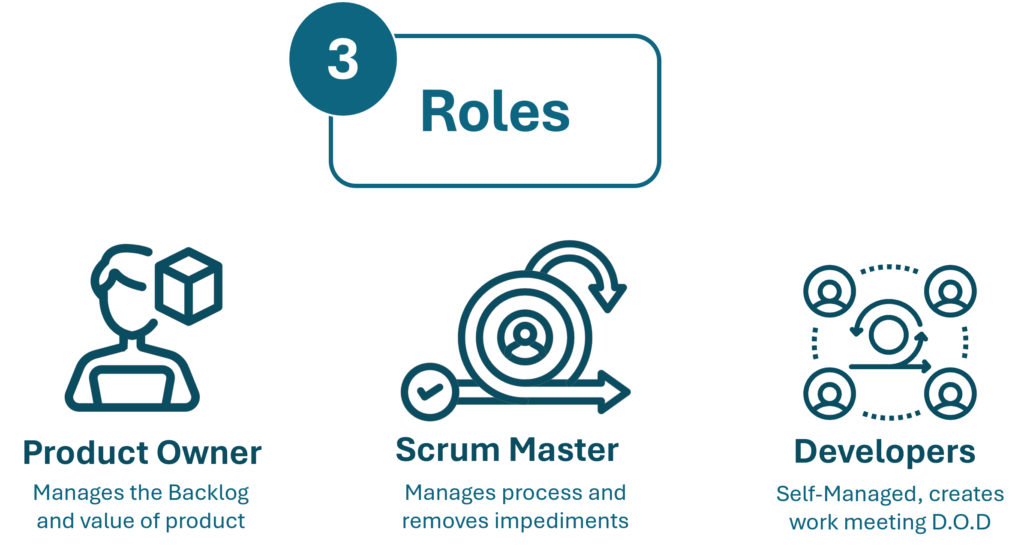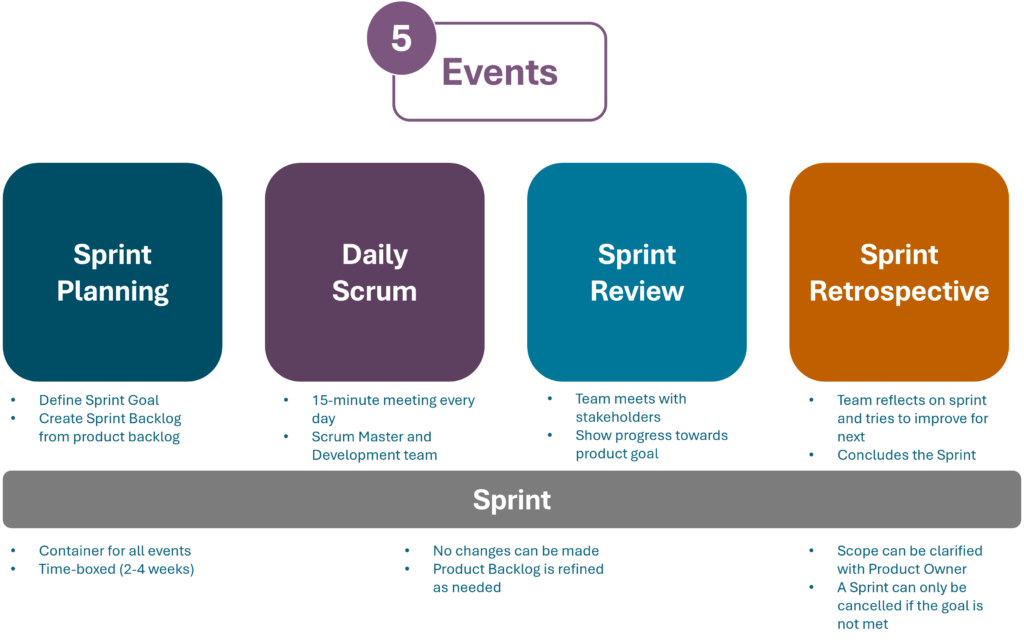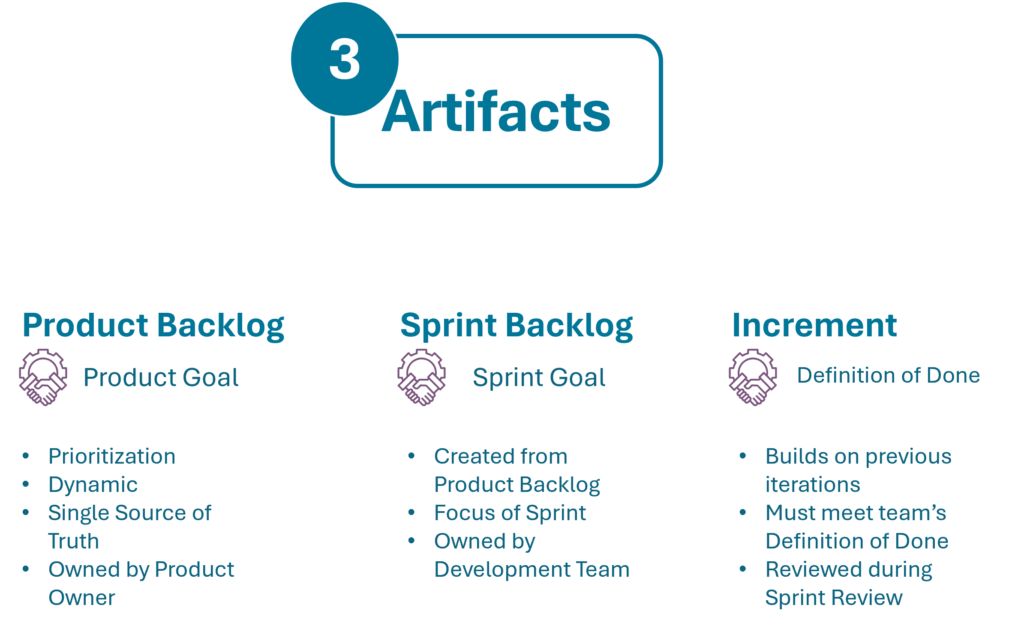Project Management Series: 3-5-3 Structure

Scrum is a popular agile methodology for developing and delivering complex products. It is based on the principles of empiricism, self-organization, and collaboration. Scrum provides a simple and flexible structure for teams to work effectively and deliver value to customers.
One way to understand the Scrum structure is to use the 3-5-3 model, which refers to the framework’s key components: 3 roles, 5 events, and 3 artifacts. In this blog post, we will explain what each of these components are and how they work together to create a successful Scrum process.

3 Roles
The Scrum team consists of three roles: the Product Owner, the Scrum Master, and the Development Team. Each role has a specific set of responsibilities and accountabilities that contribute to the overall goal of delivering a valuable product increment.
- Product Owner: Responsible for maximizing the value of the product and managing the product backlog. The Product Owner is the sole person who defines the product vision, goals, and priorities. They also communicate with the stakeholders and customers to ensure that their needs and expectations are met.
- Scrum Master: Facilitates the Scrum process, helps the team adhere to Scrum practices, and removes impediments. The Scrum Master is the servant-leader of the team, who coaches, guides, and supports the team members. They also ensure that the team has a productive and collaborative work environment.
- Development Team: A cross-functional group that works on delivering the product increment. The Development Team consists of professionals who have the skills and expertise to design, build, test, and deploy the product. They are self-organizing and autonomous, meaning that they decide how to do the work and who does what.

5 Events
The Scrum process is divided into fixed-length iterations called sprints, which usually last from 2 to 4 weeks. During each sprint, the team works on creating a potentially shippable product increment that meets the definition of done. To ensure that the team is aligned, transparent, and adaptable, Scrum defines five events that occur within each sprint.
- Sprint: A time-boxed period during which a potentially shippable product increment is created. The sprint starts with sprint planning and ends with sprint review and sprint retrospective. The duration of the sprint is fixed and cannot be changed once it starts.
- Sprint Planning: A meeting where the team plans the work to be done during the sprint. The team collaborates to select the product backlog items that they can commit to deliver and to create a sprint backlog that outlines the tasks and activities needed to complete them.
- Daily Scrum: A short, daily meeting for the team to synchronize activities and plan for the next 24 hours. The team members share what they did yesterday, what they will do today, and what impediments they are facing. The daily scrum helps the team stay on track and identify any issues or risks that need to be addressed.
- Sprint Review: A meeting at the end of the sprint to inspect the increment and adapt the product backlog if needed. The team presents the increment to the product owner and the stakeholders and collects their feedback and suggestions. The sprint review helps the team validate the value of the product and adjust the direction if necessary.
- Sprint Retrospective: A meeting for the team to reflect on the past sprint and identify improvements for the next one. The team discusses what went well, what went wrong, and what can be done better. The sprint retrospective helps the team learn from their experience and continuously improve their performance and quality.

3 Artifacts
The Scrum framework defines three artifacts that represent the work and the value of the product. These artifacts are the product backlog, the sprint backlog, and the increment. Each artifact has a clear purpose and definition, and is subject to inspection and adaptation by the team and the stakeholders.
- Product Backlog: An ordered list of everything that is known to be needed in the product. The product backlog is the single source of requirements for the product, and it is owned and maintained by the product owner. The product backlog items can be features, user stories, bugs, enhancements, or any other value-adding work. The product backlog is dynamic and evolving, meaning that it can be changed and updated based on the feedback and changes in the market.
- Sprint Backlog: The set of product backlog items selected for the sprint, plus a plan for delivering the product increment. The sprint backlog is the team’s commitment and forecast of what they will deliver in the sprint. The sprint backlog is owned and managed by the development team, who can update and modify it as needed during the sprint.
- Increment: The sum of all the product backlog items completed during a sprint and all previous sprints. The increment is the tangible outcome of the sprint, and it must meet the quality standards and the definition of done. The increment is the property of the product owner, who can decide when and how to release it to the customers.

The 3-5-3 structure in Scrum is a simple and effective way to understand the core components of the framework. By following the roles, events, and artifacts defined by Scrum, the team can deliver valuable and high-quality products in an agile and collaborative manner. If you have any specific questions about any of these components, feel free to leave a comment below or contact us for more information.